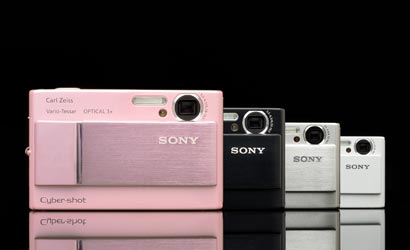Camera Review: Sony Cyber-shot DSC-T10
The Sony Cyber-shot DSC-T10 packs optical image stabilization into a slim and stylish pocket camera.

We may earn revenue from the products available on this page and participate in affiliate programs. Learn more ›
Camera Review: Sony Cyber-shot DSC-T1027242698475Sony CybershotDSC-T10I admit it — I’m an equipment pig. When we go on vacation, I bring tons of my gear- 600mm f/4, 300mm f/2.8 and a full complement of other lenses, DSLR bodies, flashes, filters, tripod, monopod and other gizmos. I’ve even packed my studio lights before because I like to be prepared for any situation! So, much to my wife’s chagrin and surprise, on our most recent vacation to Disney World I didn’t bring any of that gear with me. Instead, I packed just two Sony cameras — the Cyber-shot DSC-H5 (which will be reviewed in the coming weeks) and the small, pocket sized Cyber-shot DSC-T10 (Street price $306). The T10 is a 7.2MP camera with an iPod-like size and finish that incorporates a Carl Zeiss Vario-Tessar 3x optical zoom lens (a 35mm equivalent 38-114mm f/3.5-8 (wide angle) -f/4.3-10 (telephoto)). The T10 is Sony’s entry into the subcompact category and it sports a nice feature set — including high quality video and stunning image stabilization rolled into a stylish design. At .8 of an inch in thickness, the T10 fits nicely into your hands and pocket. The camera has a contemporary look and features a large bar on the front. The bar is more than cosmetic though, and when pushed down, reveals the lens and turns the camera on. The advantage of this is that even in dark locations, you can turn the camera on and off effortlessly without having to search for the small power button located at the top of the camera. At first, I thought this was a strange way to turn on the power, but after using this feature, I really like it and now prefer it to the traditional power button, which on the T10 is small and hard to use.
I admit it — I’m an equipment pig. When we go on vacation, I bring tons of my gear- 600mm f/4, 300mm f/2.8 and a full complement of other lenses, DSLR bodies, flashes, filters, tripod, monopod and other gizmos. I’ve even packed my studio lights before because I like to be prepared for any situation!
So, much to my wife’s chagrin and surprise, on our most recent vacation to Disney World I didn’t bring any of that gear with me. Instead, I packed just two Sony cameras — the Cyber-shot DSC-H5 (which will be reviewed in the coming weeks) and the small, pocket sized Cyber-shot DSC-T10 (Street price $306). The T10 is a 7.2MP camera with an iPod-like size and finish that incorporates a Carl Zeiss Vario-Tessar 3x optical zoom lens (a 35mm equivalent 38-114mm f/3.5-8 (wide angle) -f/4.3-10 (telephoto)). The T10 is Sony’s entry into the subcompact category and it sports a nice feature set — including high quality video and stunning image stabilization rolled into a stylish design.
| What’s Hot • Optical Image Stabilization • High quality Zeiss Optics • Easy to use On-Off via lens cover bar • One touch function buttons • Easy mode switching • Accurate battery power display • Minimal shutter lag What’s Not • Small button size • Lens placement makes it easy to accidentally obscure with a fingertip • Below average LCD viewing in bright and dark situations • Menu navigation Image Quality Gallery |
At .8 of an inch in thickness, the T10 fits nicely into your hands and pocket. The camera has a contemporary look and features a large bar on the front. The bar is more than cosmetic though, and when pushed down, reveals the lens and turns the camera on. The advantage of this is that even in dark locations, you can turn the camera on and off effortlessly without having to search for the small power button located at the top of the camera. At first, I thought this was a strange way to turn on the power, but after using this feature, I really like it and now prefer it to the traditional power button, which on the T10 is small and hard to use.
The top center of the camera has a switch that allows you to move from review to shooting still images and video. I have to say that this was one of the most used features on the camera because you’re able to go through the different functions without using a menu or turning a dial. It’s quick and very efficient. I turned the auto review feature off and simply moved the switch over to review if I wanted to see my images. The advantage of this is that if you’re shooting more than one frame at a time you don’t have that interruption between frames but still have the ability to go back and review all of the shots when you’re ready.
Inspecting the back of the camera shows a 2.5 inch (230,000 pixel) LCD screen that’s both the viewfinder and reviewing/function screen. The images are sharp but dark in both daylight and surprisingly, in dark conditions as well, even when set to the “Bright” LCD setting.
Next to the screen is a host of other buttons that improve efficiency as well. Depress the monitor icon button once and it will show the battery life, shooting resolution and number of images shot and available for shooting to your Memory Stick Duo and Memory Stick Pro Duo media. If you’re in review mode and press the same button once more it shows all of the above information and ISO settings, flash status, white balance status, exposure setting and histogram for the active review image. In shooting mode, it shows the histogram. If you press the lower right button, you can set the EV settings between -2 to +2 in full view of the histogram. Depress that same monitor button a third time and all of the information goes away, showing only the image. Other features that can be activated at the touch of a button include flash mode, macro settings, self timer and a toggle switch between active shooting mode and the last frame shot.
If you switch the camera back to review mode and select the same button that shows the EV settings in shooting mode, you’ll see a slide show of all your images — complete with a cool techno-style bed of music and transitions that make some of the full feature video editing programs look second-rate. Sony also allows you to upload music into the 56MB of internal camera memory if you don’t like the supplied music.
No Presets, No Problem
Surprisingly, the T10 doesn’t have a huge supply of “scene” settings — simply because the design of the camera is such that it really doesn’t need them. The T10’s ISO range goes up to 1000 and if you combine this with the optical image stabilization features built into the camera, the T10 can shoot in almost any situation without a lot of presets. Simply point and make your image and the camera does the rest. Almost without exception, the images made are amazingly sharp and very well exposed. I say amazing because some of the shots made were with exposures of as long as a full second hand-held. Add to this the legendary sharpness of the Zeiss lens, and you have an image that looks good even as a big enlargement. The Zeiss lens also enhances the sharpness of the NTSC quality video. The T10 converts video to an MPEG file that’s ready for viewing either on camera, on the Internet or a workstation. Like many cameras in this class, the video will work at only one focal length and can not zoom while the video is running. The best work-around for this is to stop the video, change focal length and start the video once again.
The T10 also uses a Lithium-Ion “smart” battery that can tell the camera precisely how much of the battery power is available. I found this to be more accurate than similar cameras and shot for a full 12-14 hours with all of the photo-chimping in between on a full charge. The battery is rated at 250 shots using the CIPA standard testing method, but we think turning the instant review off will up this number.
Another surprise for the T10 is how quickly the shutter release worked. In many cameras similar to the T10, one chip is used instead of the more expensive multiple chip designs common in DSLR cameras. The result is typically a shutter lag. In the T10, there is little if any lag. The T10 incorporates a focus assist beam that’s above average in brightness and keeps the quickness of the camera to near daylight levels even when the light isn’t great.
Like many cameras in this category, designers realize that space is at a premium, so often times, the interface falls short. In the T10’s case, this means making the user buttons smaller and harder to use. It would also be nice if Sony designed the lens to be more centered — giving your fingers more working room. The problem with designing a lens location in the upper corner of the camera is that many people will place a finger into part of the image. Sony certainly isn’t alone in this category, and the bar lowered down does help in relieving this problem, but it’s not foolproof. The 38-114mm zoom is also becoming a standard lens for cameras such as the T10. While this is a useful range, it would be wonderful to have a camera of this size and quality that has a 5x or even 10x optical zoom that maintained the same image quality level. In the T10 and other Sony models, the menu is useful, but clunky. A thorough revamp of the menu design is needed to make this camera truly head-and-shoulders above the competition.
Most of these shortcomings are minor, and for many a casual shooter, may not matter at all. Ultimately, it’s image quality that really matters and Sony has earned very high marks in this category with the T10. Using a Zeiss lens in tandem with the superior optical image stabilization makes for great picture taking in a slim, stylish package.
In The Box:
Sony DSC-T10 camera
Wrist strap
USB/AV/DC-in multiconnector cable
NP-FT1 Info-Lithium battery pack and charger
Software CD
Instruction manual and registration card
Dimensions:
3 17/32″ x 2 5/32″ x 25/32″ (89.7 x 54.9 x 20.6 mm)
4.93 oz (140 g) Body, 5.82 (165 g) including Battery and Memory Stick Media
CIPA Battery Estimate: 250 shots

Winnie-the-Pooh-waves-to-the-crowd-during-a-parade

All-three-of-my-children-left-to-right-Parker

My-two-younger-children-Tanner-left-and-Parker

My-wife-Kristi-and-two-youngest-children-ride-the

Dancers-perform-down-Mainstreet-U.S.A.-during-the

A-one-second-hand-held-exposure-of-Cinderella-s-C

A-Gypsy-Moth-frequented-the-exterior-of-our-unit-a